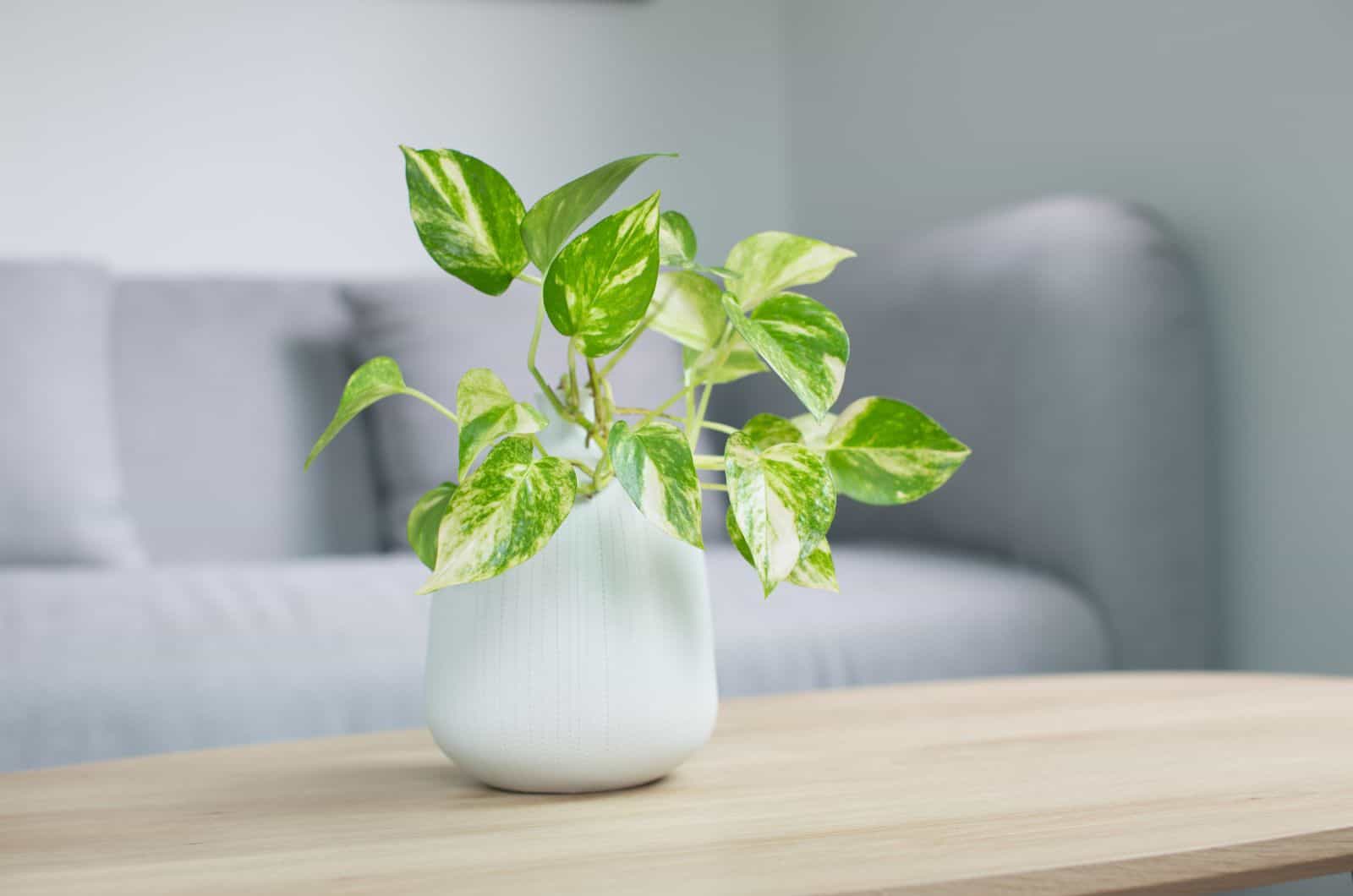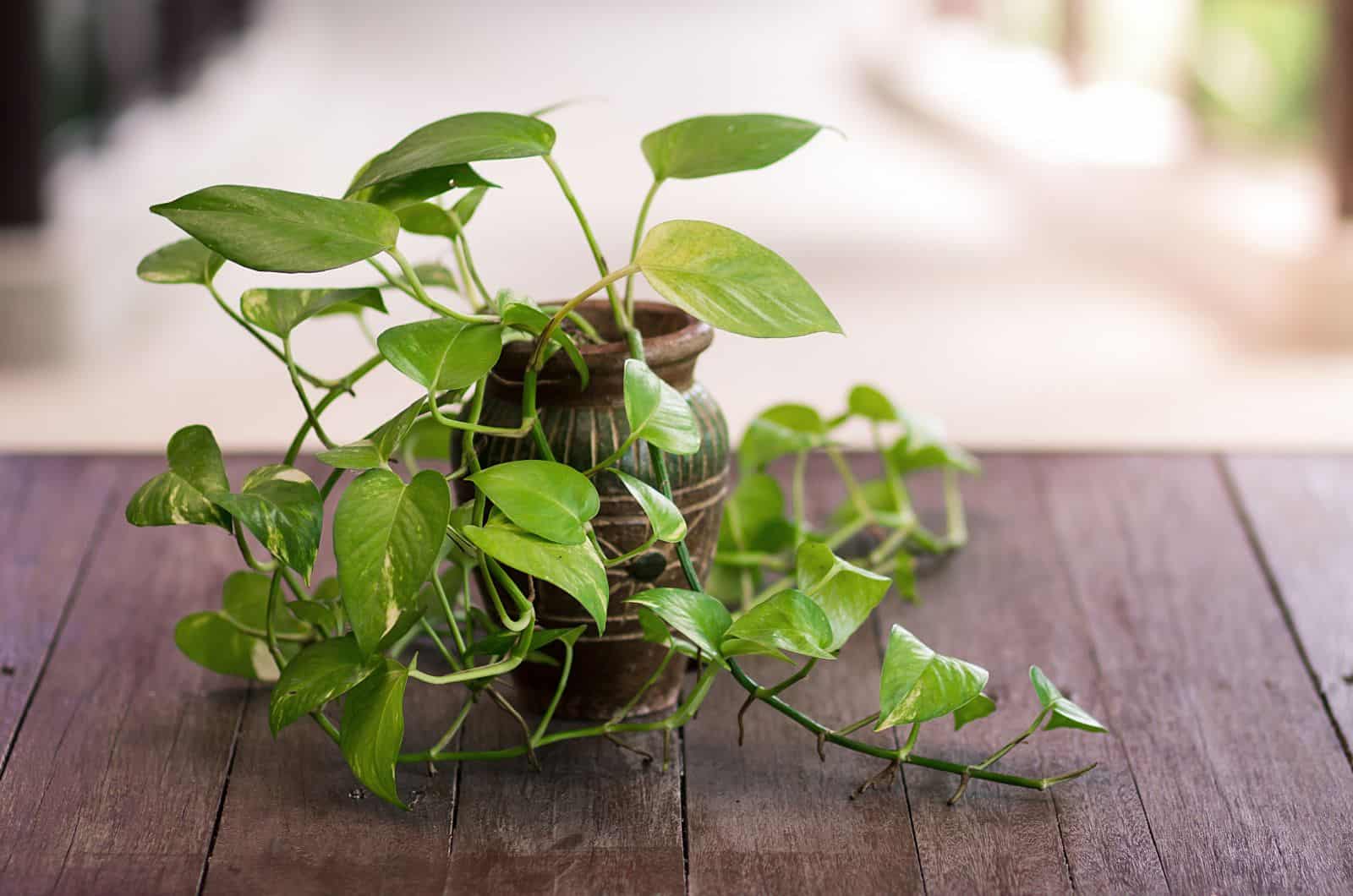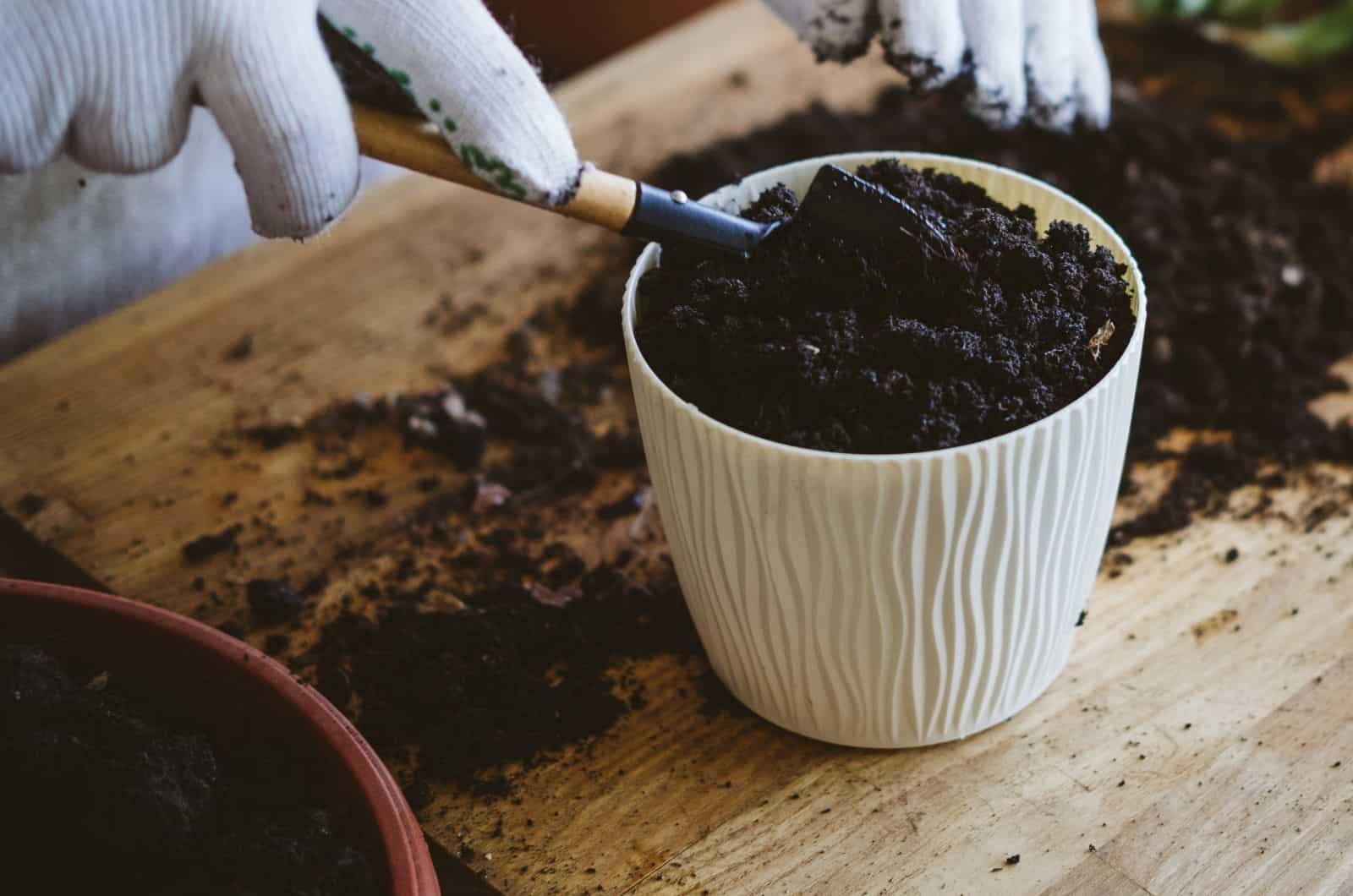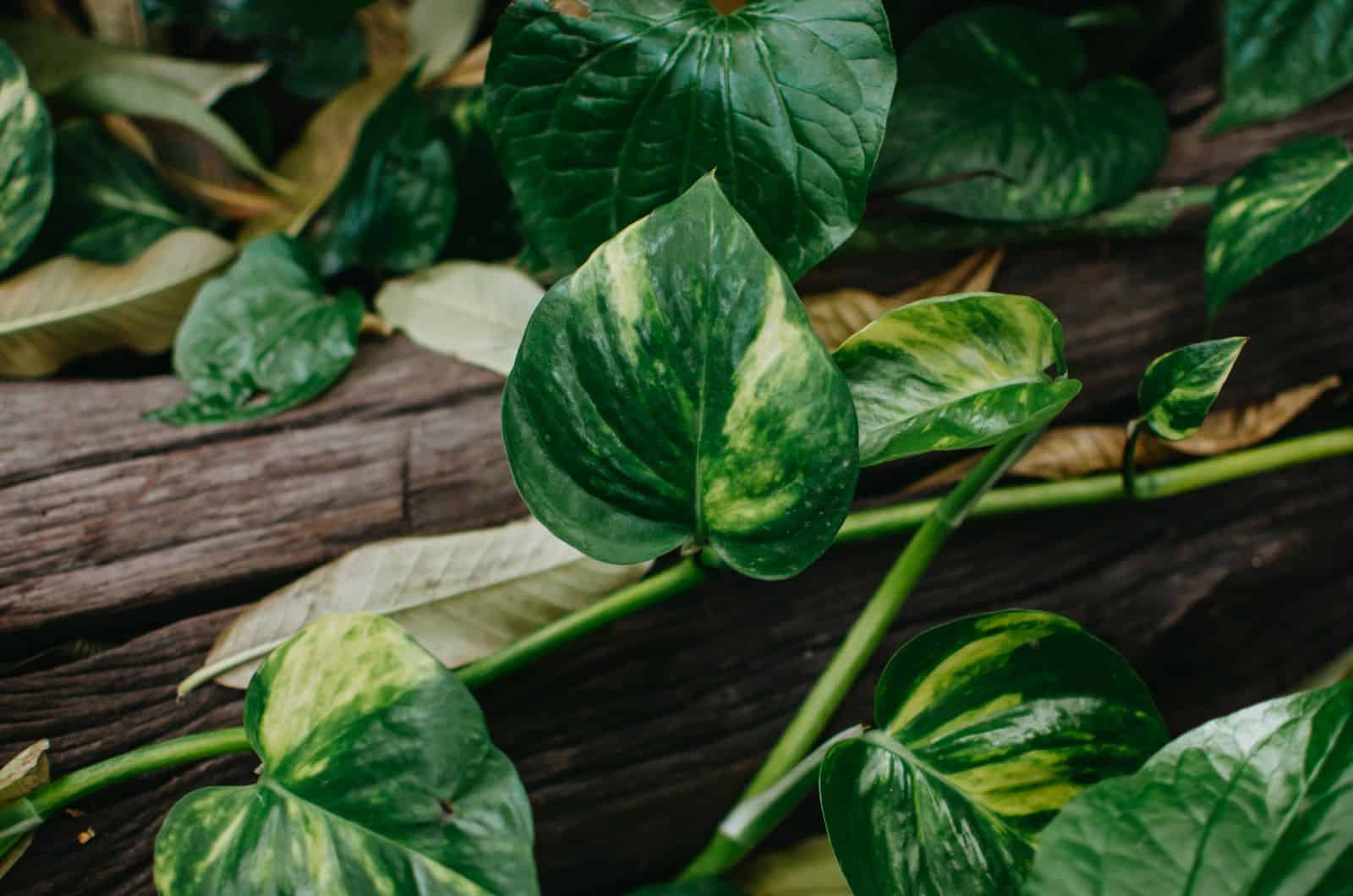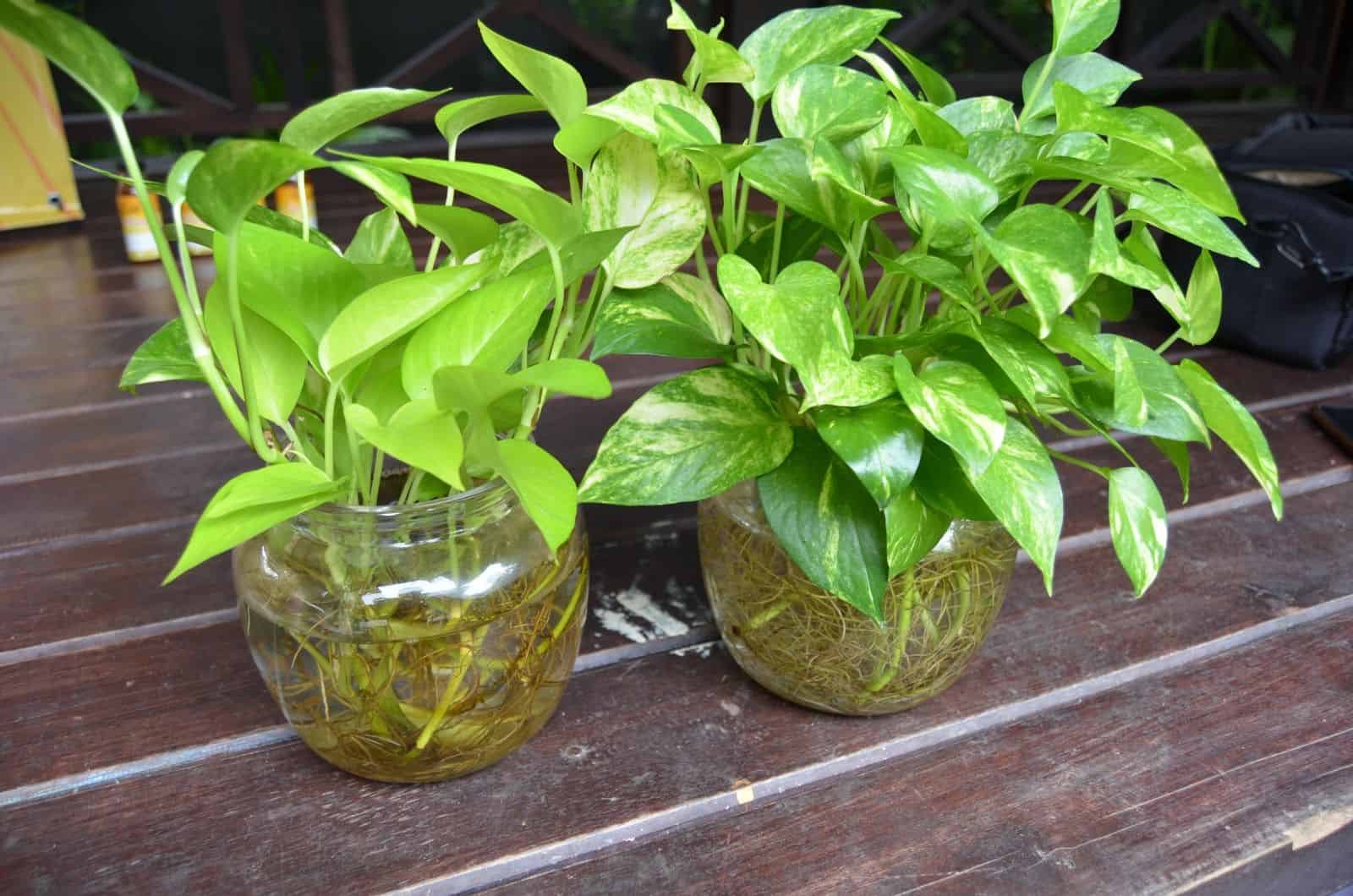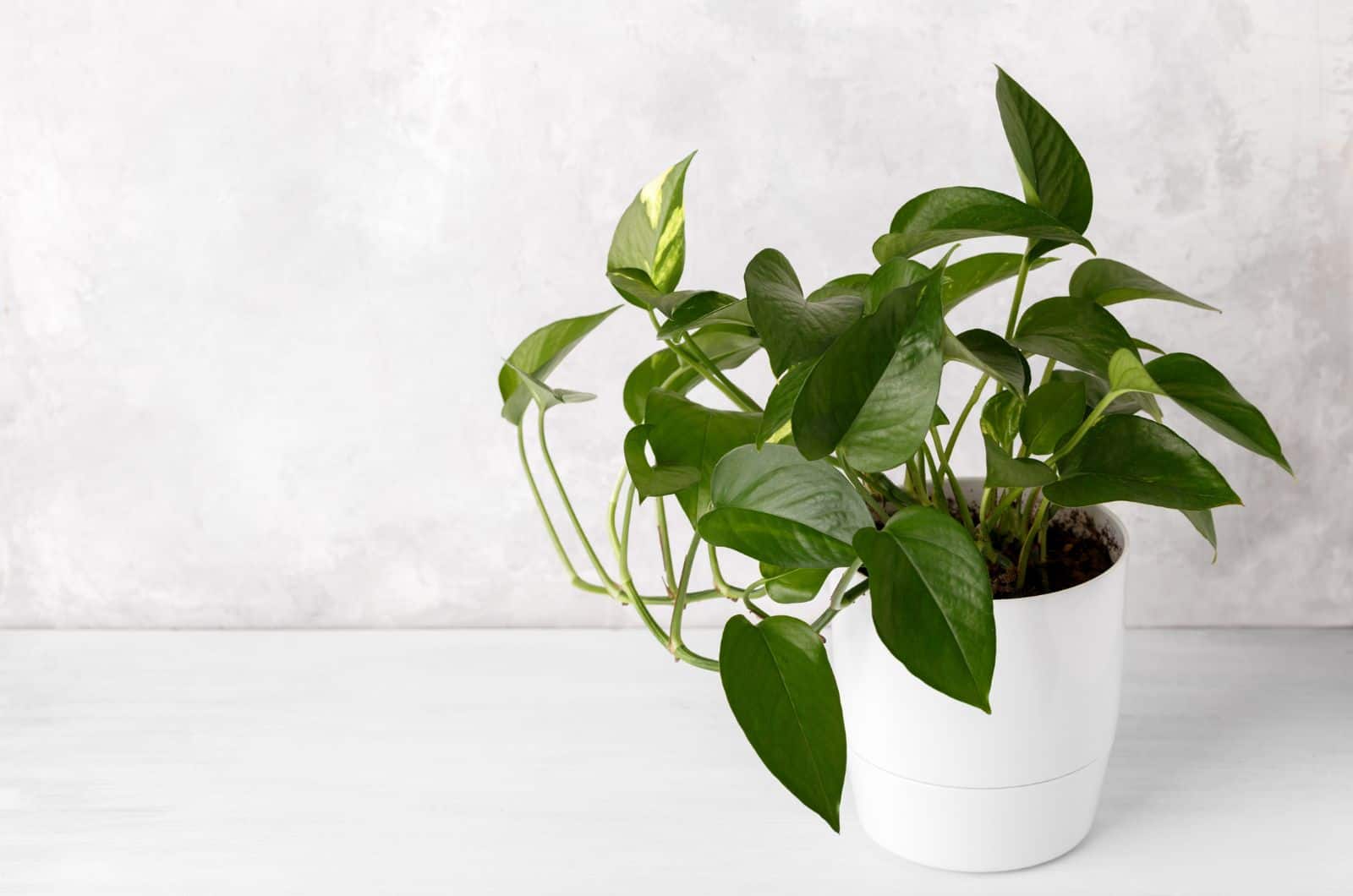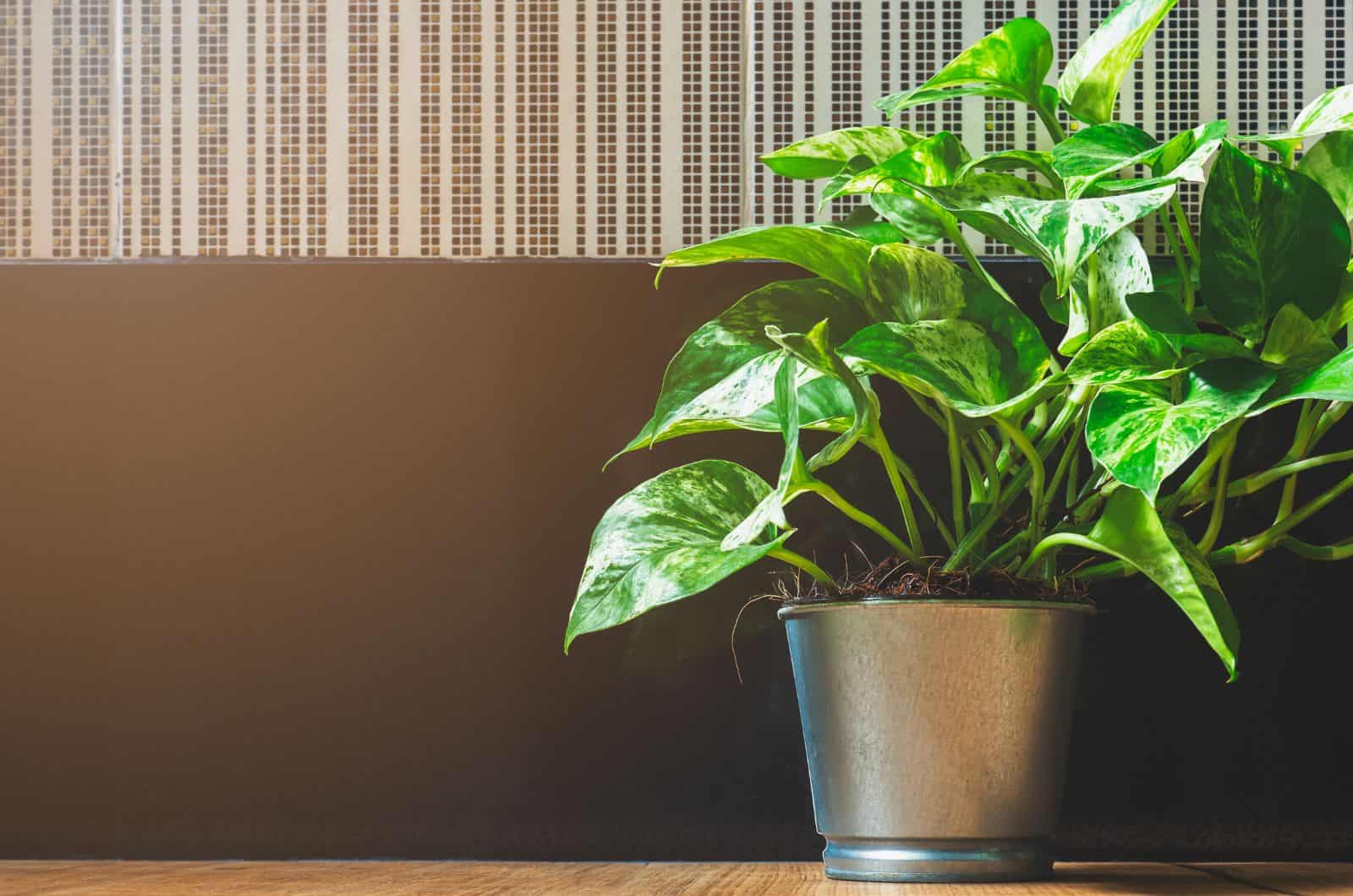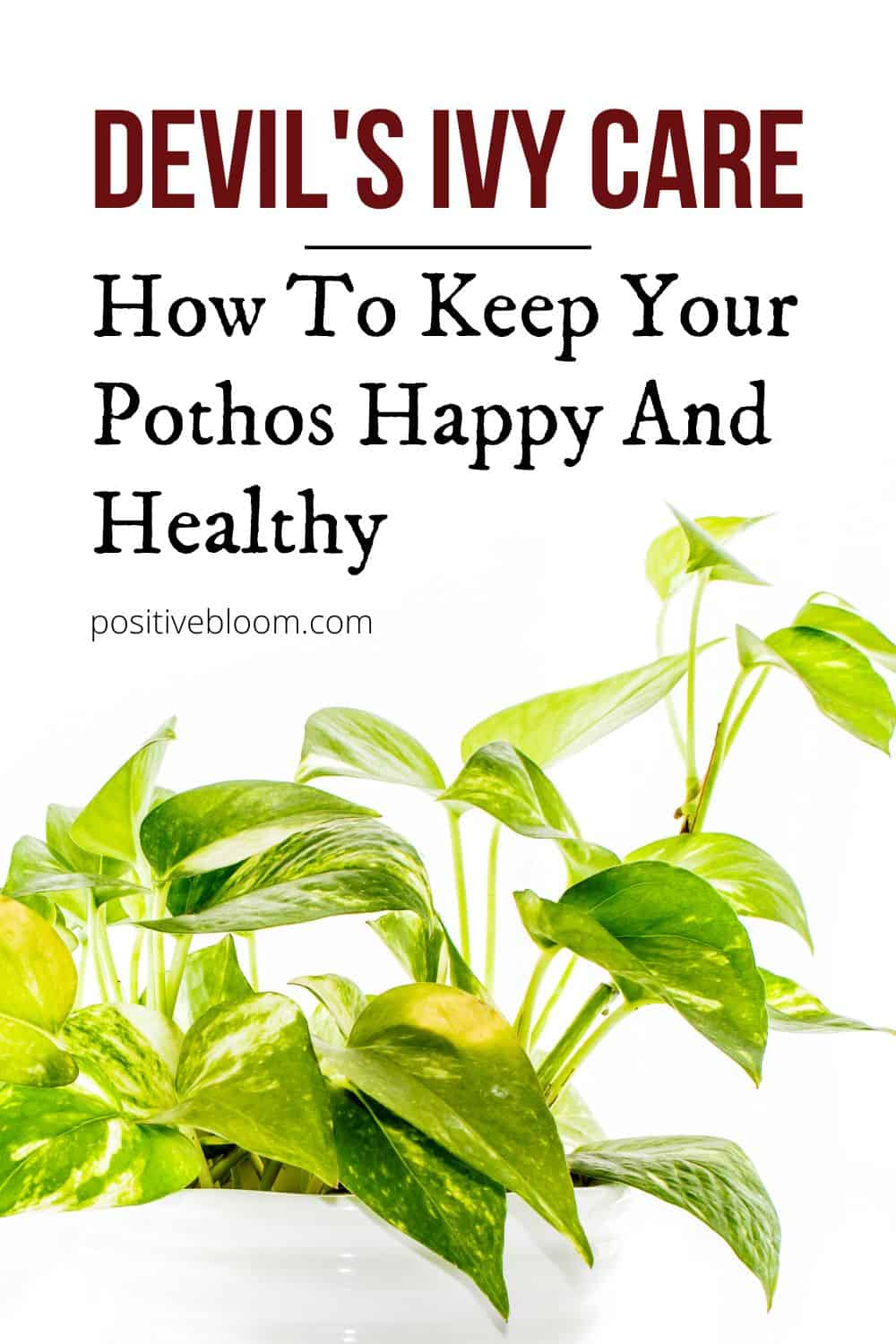When I first heard of the devil’s ivy plant, I admit I was pretty put off by the unattractive name.
The plant got this strange name as it’s hardy and almost impossible to kill.
I started growing one myself, and I need to tell you that it became one of my favorite houseplants because it really doesn’t need much to be happy.
I made a complete guide on devil’s ivy care, so after reading this article I’m sure your precious pothos will thrive like never before.
Let’s start with some basic info about the devil’s ivy plant:
| Family | Araceae |
| Genus | Epipremnum |
| Scientific name | Epipremnum aureum |
| Common names | Devil's ivy, pothos, taro vine, ivy arum, golden pothos, hunter's robe |
| Natural habitat: | Solomon islands |
| Plant type: | Climbing vine |
| USDA hardiness zones: | 10-12 |
Devil’s Ivy Care: What Does Your Pothos Need For Healthy Growth?
When discussing the term low-maintenance with regard to plants, I must mention that even hardy plants such as pothos can’t be completely neglected.
Here is a table with a short pothos care guide:
| Light | Bright indirect light |
| Temperature | 65-85 degrees Fahrenheit |
| Humidity | From 50 to 70% |
| Soil | Well-draining, porous |
| Watering | Top 2 inches should be dry before watering |
| Fertilizing | Once a month during the growing season |
| Pruning | Occasional |
| Repotting | Every 1-2 years |
Light Requirements
Generally, pothos plants require bright indirect light. For beginner growers, this part may be pretty tricky.
Your devil’s ivy needs sun, but it needs to be filtered so it doesn’t scorch the leaves and cause sunburn. Additionally, direct sunlight increases a pothos plant’s need for water, which may result in dehydration.
When growing this Epipremnum plant indoors, you’ll need to place it somewhere it doesn’t receive intense sun rays.
I keep my pothos near an east-facing window so it receives direct sun in the morning, but the rest of the day in indirect sunlight.
I have good news for you! The pothos is an excellent low-light indoor plant. However, you might notice stunted growth if the plant doesn’t receive enough light or the spot is too dark. In this case, I recommend buying grow lights to increase the light level.
Your devil’s ivy may lose its variegations if grown in too low light, so please be careful with the light conditions and monitor your plant.
Temperature Requirements
The Epipremnum aureum isn’t fussy about temperature, and it will grow well at room temperature.
If the temperatures in your home are lower than 60 degrees Fahrenheit, your taro vine may struggle to grow.
On the other hand, it won’t do well if the temperatures are too high either, so don’t let the temperature go above 85 degrees Fahrenheit or it can cause your plant to wilt or droop.
Another problem with either too high or too low temperatures is that they change the watering needs of this plant. If they’re too low, they’ll decrease the water evaporation rate, so you risk overwatering.
In contrast, high temperatures increase the water evaporation rate, so your pothos may quickly become dehydrated in this case.
Temperature fluctuations and cold drafts should also be avoided unless you want to shock your plant.
Humidity Requirements
The Golden pothos is native to the Solomon Islands, so it requires high humidity.
You’ll need to raise the humidity to keep your plant healthy and promote new growth.
Gardeners use several methods for increasing humidity, and I’ll show you the best ones now.
Misting
Occasionally spraying plants with water is a good technique to keep hunter’s robe plants hydrated.
Mist your plants regularly, but pay attention to the leaves as they shouldn’t be wet. Wet leaves attract bacteria and fungi.
Moving Houseplants To More Humid Rooms
Moving ivy arum plants to a more humid environment, like a kitchen or bathroom, is also a good way to raise humidity levels.
Your Epipremnum aureum will appreciate it, and your kitchen or bathroom will look amazing.
Grouping Houseplants
Another effective technique is moving and grouping plants together to make a microclimate. However, this does not significantly increase humidity levels.
This approach wouldn’t be very helpful on its own if you reside in a dry area where indoor humidity doesn’t surpass 30%.
Place your pothos near Epipremnum aureum ‘Neon’ plants, Monsteras, or Philodendrons (if you grow any), and use another DIY method for raising humidity as well just to be sure.
Using Pebble Trays
All you need to put together a pebble tray is some pebbles or gravel, water, and a shallow dish.
Place your ivy arum on the tray and add water, but make sure the leaves don’t touch the liquid.
Using Humidifiers
A humidifier is practical, easy to use, and doesn’t disrupt the room’s aesthetics.
In my opinion, this is the best method for raising humidity levels, especially for beginner growers.
Although this device may seem expensive, it is worth every penny.
The Perfect Potting Mix For An Epipremnum Aureum
Many growers have discussed whether a pothos needs drainage, and the answer is a resounding YES. All plants from the Epipremnum genus require fertile, porous, and well-draining soil.
These plants despise compact soil because it retains water and increases susceptibility to fungus and bacteria, which may result in root rot.
Remember that the container type can also aid drainage, so you should buy containers with drainage holes.
I recommend making your own soil mix using these great materials that pothos plants love.
• Peat moss: This material retains water well so that the soil will stay moist, just like ivy arum likes.
• Vermiculite: Promotes water and nutrient absorption, and also makes the soil porous.
• Gardening sand: Makes the soil porous and promotes drainage.
• Perlite: Great for water absorption and contains a lot of air pockets.
• Orchid bark: Promotes drainage and aeration.
• Coco coir: Considered to be an alternative to peat moss as it retains water well.
How Often Should You Water Devil’s Ivy?
Never depend on a set timetable for watering because many external factors, such as humidity, light, and temperature, may increase or decrease watering needs.
Completely dry potting soil is bad for your devil’s ivy, and your pothos is underwatered if its leaves are drooping, browning, and yellowing, and the plant is wilting.
On the other hand, soil moisture shouldn’t be too high. These plants hate soggy soil, and you’ll be dealing with an overwatered pothos instead of a healthy plant in this case. The signs include yellow leaves, brown spots, moldy soil, root rot, and wrinkled leaves.
Water your hunter’s robe plant when the top 2 inches of the soil are dry.
Watering Technique
The easiest way to avoid overwatering your ivy arum plant is by watering it using the bottom watering technique.
Put your plant in a sink or sizable bucket, and let the soil absorb water gradually.
Be cautious because this technique may lead you to believe that you have completely watered your plant, while the middle of the potting mix may still be dry.
Just insert your finger in the pothos soil to see if it’s sufficiently moist.
Ideal Time To Water
The water evaporation rate is the primary element for determining when to irrigate these plants.
I highly recommend watering your ivy arum plant in the mornings in order to allow the water to evaporate slowly during the day.
Cooler night temperatures reduce the water evaporation rate, so avoid watering at night.
When And How To Fertilize A Pothos Plant
This Epipremnum plant doesn’t require much feeding. It would be best if you fed it monthly during the growing season to promote growth and supply it with new nutrients.
This cultivar goes into dormancy in the colder months, and can’t utilize all the nutrients you provide it with at that time, so don’t feed it then.
This indoor plant requires little food, so to make it happy just add compost at the beginning of the growing season.
If you decide to use chemical fertilizers, use a well-balanced, water-soluble houseplant fertilizer.
When And How To Prune A Pothos Plant
Pruning has numerous benefits for plants.
For example, if you don’t cut unhealthy leaves from the ivy arum plant, the disease may transfer to healthy sections. So, grab your shears and start trimming!
Leaves that are wrinkled, old, discolored, or diseased have no place on your precious plant. In fact, they still use nutrients and water, or should I say waste them, and new growth is significantly disrupted.
You can also trim your Epipremnum aureum to increase the growth rate or achieve the desired shape.
The only thing you should pay attention to is not removing more than one-third of your devil’s ivy plant as it could harm and weaken it.
How To Repot Devil’s Ivy
Plants from the Epipremnum genus grow pretty fast, so it’s not surprising they require more frequent repotting.
The best time to repot these plants is during their growing season, i.e., from spring through summer.
Each time you repot these plants, they go through a certain amount of shock and are temporarily unable to absorb nutrients or water.
Repotting during spring gives them enough time to get used to their new surroundings and recover from the shock before going dormant.
If your plant is supported by a structure such as a moss pole or something similar, you’ll need to repot the plant with the stake still in place.
Hold the stake with one hand, tilt the container slightly with the other, get rid of some soil, and take your plant out. Once your hunter’s robe plant is out, transfer it to a new and clean container filled with fresh potting mix.
Place your ivy arum with a pole inside the container, top it off with extra soil to stabilize the stake, and give the plant plenty of water.
How To Get Your Pothos To Climb
You can grow this Epipremnum as a trailing plant. If you want it to climb attach it to a structure, such as a moss pole or trellis.
After giving your plant anchored support, loosely attach the pothos aerial roots to it. The roots will simply climb up if you give them something to hold onto.
By training your pothos to trail, you will mimic its native environment where they typically climb tall trees and rely on them for support.
These plants look adorable when grown in hanging baskets, which is the best way to decorate your household and accentuate its heart-shaped leaves.
Devil’s Ivy: Propagation Methods
When it comes to devil’s ivy, you can use two plant propagation methods – stem cuttings and air layering.
Let’s take a closer look at each method.
Stem Cuttings
You can quickly get new, fast-growing Scindapsus plants by using stem cuttings.
Before I show you how to do it, I need to tell you what to prepare. Remember that propagation will only have a positive outcome if your taro vine plant is healthy.
This is especially important for the stem you intend to cut. If you notice any browning, yellowing, wilting, or drooping, try to determine the cause before you start propagating.
Let’s move on to the equipment. You’ll need some tools for indoor gardening, such as a sharp knife or a pair of scissors, some rooting hormone, nursery pots, fresh potting mix, a transparent jar, and sanitizing solution.
Here’s the procedure:
Take The Cuttings
Sanitize your knife or scissors, and select a healthy stem on the parent plant with at least 2 nodes. After you make a clean incision below the leaf node, you’ll need to get rid of the bottom leaves.
This is an essential part of the procedure as leaves that are submerged in water or buried in the soil tend to rot, which can cause the procedure to quickly fail.
You can either cut off the leaves with a sharp knife/shears or carefully pull them from the cutting.
Leave one or two leaves on the upper part of the cutting.
Root The Cuttings
You can choose between two rooting mediums – water and soil. If you decide to use water propagation, fill a transparent jar with fresh, lukewarm water.
Put the cutting in water, making sure the leaves are above the water line and at least one node is below.
Change the water weekly to avoid contamination. Wait for a few weeks, and when you spot new roots it’s time to transplant them.
If you’re rooting ivy arum cuttings in soil, first dip the cuttings in a rooting hormone (powdered or liquid).
Make a tiny hole in the potting mix and insert the cutting that has been treated with rooting hormone into the hole.
Just like with water propagation, ensure the devil’s ivy leaves are above the soil line and the nodes are below.
Carefully and firmly press the soil down to secure the cutting in place.
Transplant The Cuttings
After your cutting develops roots (in either water or soil), it’s time to transplant it.
Make sure the soil mix you use is fresh and not taken from the garden. Gently place the taro vine cuttings in the soil, water them, and put them in a warm spot with indirect light.
Air Layering
This Epipremnum plant can quickly and successfully be propagated with the air layering method.
First, select a healthy offshoot that has aerial roots attached. Insert the air roots in the potting mix and secure the hunter’s robe offshoot in the soil mix.
Make sure the offshoot is always moist but never soggy.
Once you notice new roots, remove the offshoot with roots from the parent plant. Prepare fresh potting mix and a new pot, and repot the rooted offshoot.
Common Issues
Epipremnum plants are hardy and usually don’t suffer from many issues during their life cycle.
However, they aren’t completely problem-free because pests, diseases, discoloration, or structural change can all occur.
Let’s find out more!
Pests & Diseases
Although pests and illnesses are frequently to blame for dying plants, there are some ways to bring a taro vine plant back to life even after it has been attacked by pests or contracted a disease.
If your hunter’s robe plant is weak it will quickly attract various pests and diseases, and to avoid this you should use the care tips I gave you above.
Mealybugs, spider mites, and aphids love Epipremnum plants. These insects make your houseplant droop by consuming its main organs, such as the leaves and stems.
Severe infestations may kill your ivy arum, so take action as soon as you spot these tiny creatures.
Horticultural oil and other methods for pest control during flowering may help you get rid of the infestation.
Diseases
The most prevalent diseases that affect Epipremnum plants are root rot, leaf spot, and powdery mildew.
I mentioned that poor drainage, wrong potting mix, and an inadequate watering schedule might lead to overwatering, which is one of the most common causes of a deadly disease known as root rot.
You should constantly inspect the soil if you detect any sign of root rot, such as discolored leaves (yellow or brown), droopiness, wilting, or the plant experiencing stunted development. Take your taro vine out of the pot and check the roots.
You can revive your dying pothos by cutting off the diseased roots, applying fungicide, and changing your plant care habits.
Leaf Discoloration
Overwatering, underwatering, and direct sunlight can all cause yellow leaves, so you need to inspect the plant further if you see any.
The same goes for brown leaves. However, if the browning occurs on the leaf edges only, you are most likely dealing with underwatering.
Black Spots
If there are any black spots on the leaves or anywhere the entire plant, you have most likely overwatered it.
If the soil is soggy, develops mold on the surface, and smells bad, then you are dealing with root rot.
Devil’s Ivy Losing Variegation
Devil’s ivy is recognized due to its magnificent green leaves that have stunning variegation. But, if your plant is losing variegation you’ll need to check a few things.
If you keep your plant in a dark corner, it will most likely lose its variegation because plants need a lot of bright light to preserve such an appearance.
Don’t worry, you can bring variegation back if you move your taro vine where it can get a lot of bright indirect light.
Leaves Curling
If your devil’s ivy displays curly leaves, it definitely needs further inspection.
There are many possible culprits for this, such as too much water, not enough water, fertilizer issues, humidity, and light issues.
However, devil’s ivy leaves may curl naturally. Older leaves, for instance, will curl, become discolored (yellow and brown), die off, and finally drop off.
When new leaves appear and curl inwards, don’t be alarmed as this indicates a healthy Epipremnum aureum plant.
FAQs
Is the Devil’s Ivy good for indoors?
Devil’s ivy is an amazing choice for your plant collection. This is an air purifying plant, so it’ll remove toxins from the air in your household.
Additionally, this is a hardy plant, which means it’s very hard to kill. If it’s not satisfied with the conditions you provided, it’ll show you by displaying changes on the leaves or stems.
However, it won’t instantly die, though I’m sure you’d rather have enough time to figure out what’s wrong.
The only disadvantage of this plant is that it’s toxic to both humans and pets, so if you decide to grow it, make sure it’s out of reach.
What is the best time of year to plant a Devil’s Ivy?
The best time of year to plant Devil’s Ivy is in the early spring, and this is also the best time to repot, prune, and propagate this plant.
Remember, the Epipremnum aureum grows actively during spring and summer, so it will recover sooner from pruning, repotting, planting, or any other activity.
What does Devil’s Ivy like?
Devil’s ivy features heart-shaped, green leaves with yellow or white variegations. This is a low-maintenance plant and can survive in pretty harsh conditions.
The Golden pothos is often confused with Hawaiian pothos, but they differ in variegation colors, fenestrations, vine color, and flowers.
Wrapping Up
All Epipremnum cultivars, such as marble queen, neon, devil’s ivy, and snow white, look fascinating and are easy to maintain.
Devil’s ivy care won’t take much of your time, and you’ll be able to enjoy the amazing heart-shaped leaves without putting much effort.
I’m sure our care tips will help you get a happy and healthy pothos!
Until next time!
Like this post? Share or save it for later!

